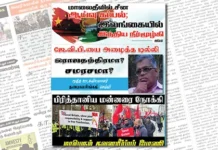At last investors in some of South Asia’s most depressed financial markets have something to celebrate.
Optimism about a turnaround in crisis-ridden Sri Lanka and Pakistan saw stock gauges in both countries test their best intra-day gains in more than a decade. Sri Lankan stocks surged after the launch of a domestic bond swap program, while Pakistan’s benchmark climbed by the most since 2008 on Monday after an International Monetary Fund loan deal eased default concerns. The Pakistani rupee climbed 4% to 275 per dollar.
“What we’re seeing now is a relief rally both in equities and bonds,” said Emre Akcakmak, a Dubai-based senior consultant at East Capital, adding that the progress of restructuring talks in Sri Lanka and political developments in Pakistan will guide investors forward.
The moves may lead to assets in both the nations extending gains after a torrid couple of years that saw Sri Lanka default in 2022 and foreign exchange reserves drop to dangerously low levels in Pakistan. Dollar bonds and currencies for both economies also gained after returning from market holidays.
Stocks in Sri Lanka have an upside of 50% and Pakistan about 75%-120% on the basis of normal valuations seen in recent past, said to Mattias Martinsson, chief investment officer at Stockholm-based frontier market investors Tundra Fonder AB, adding that Sri Lanka looks far more likely to hit those kind of valuations in the next 12-24 months with its economy improving quickly.
Funding from multilateral lenders has bolstered investors’ confidence — and returns — across troubled emerging and frontier markets in recent months. Though further re-rating will depend on how these economies fare in the next few months, according to investors, leaving little room for policy errors.
“As long as the IMF is kept on board and political protests are kept at bay, domestically, and food and fuel commodity prices stabilise and US rates ease, externally, then both equity markets are set fair for now,” said Hasnain Malik, a strategist at Tellimer in Dubai. “Of course, having any confidence in the structural reforms necessary to underpin a longer-term investment case is a completely different issue.”
Further funding support from friendly nations is also a lingering risk as Pakistan stares at a $25 billion debt repayment wall in the year starting July. Elections due later this year will also test Islamabad’s commitment to implement reforms.
While for Sri Lanka, all eyes are now on how fast the debt talks with official creditors including China, India, and the Paris Club as well as foreign bondholders move.
Foreign creditors are agreeable to restructuring the nation’s debt as per International Monetary Fund criteria to reach sustainability, Foreign Minister Ali Sabry said on Monday. Striking a deal will be critical for unlocking IMF funding to keep its economic growth recovery on track.
Columbia Threadneadle expects more gains in Sri Lanka’s dollar debt, for which they see a recovery value in the mid-50 cents on the dollar.
Sri Lanka’s 7.55% 2030 bond was indicated gaining 0.7 cents to 44.9 cents on the dollar, while the Sri Lankan rupee advanced 0.4% to 305.6 against the dollar. Pakistan’s 2024 note maturing in April was indicated surging nearly 5 cents to 77.8 cents on the dollar.
Bloomberg





